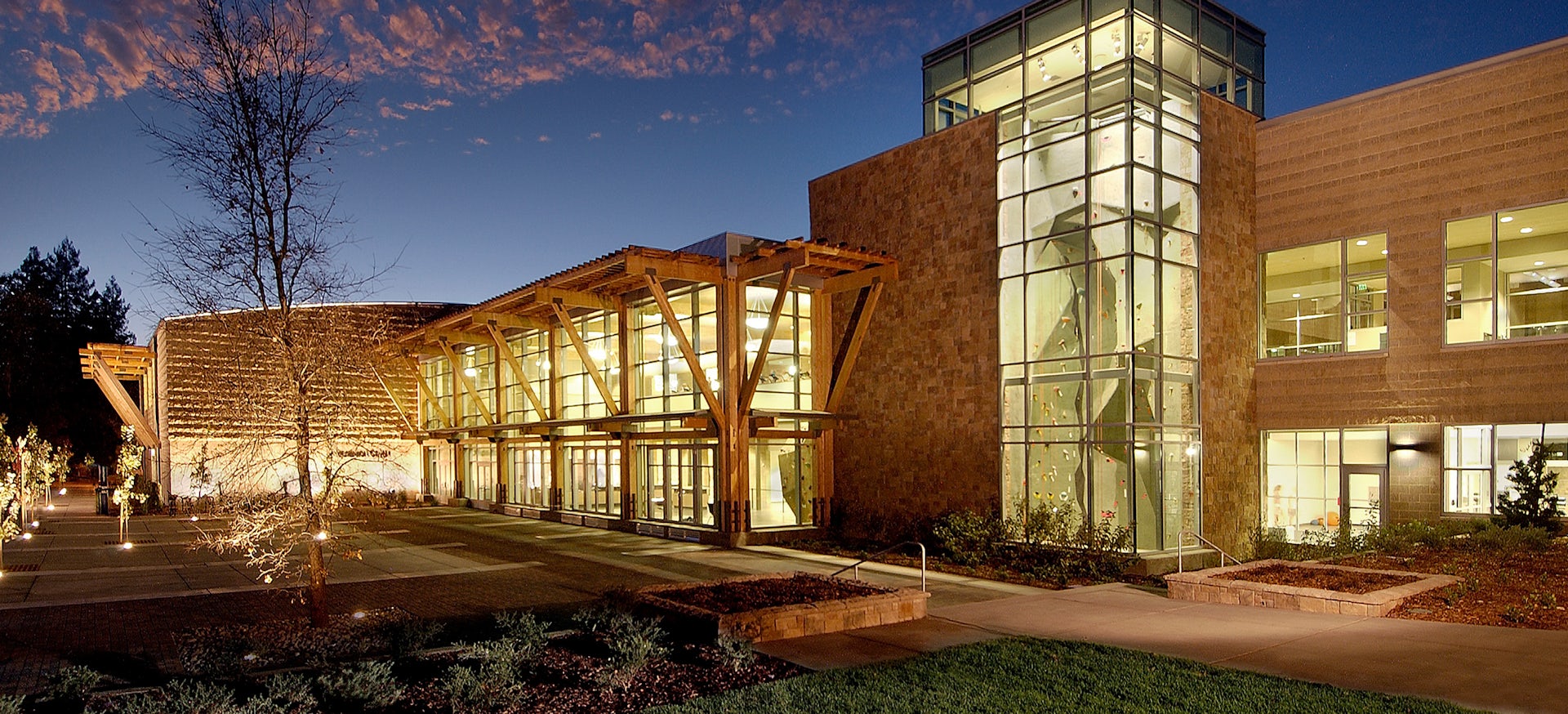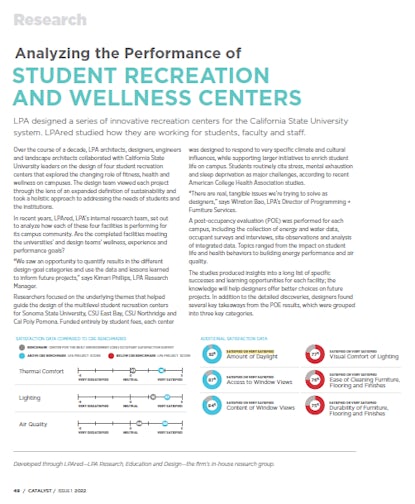Over the course of a decade, LPA architects, designers, engineers and landscape architects collaborated with California State University leaders on the design of four student recreation centers that explored the changing role of fitness, health and wellness on campuses. The design team viewed each project through the lens of an expanded definition of sustainability and took a holistic approach to addressing the needs of students and the institutions.
In recent years, LPAred, LPA’s internal research team, set out to analyze how each of these four facilities is performing for its campus community. Are the completed facilities meeting the universities’ and design teams’ wellness, experience and performance goals?
“We saw an opportunity to quantify results in the different design-goal categories and use the data and lessons learned to inform future projects,” says Kimari Phillips, LPA Research Manager.
Researchers focused on the underlying themes that helped guide the design of the multilevel student recreation centers for Sonoma State University, CSU East Bay, CSU Northridge and Cal Poly Pomona. Funded entirely by student fees, each center was designed to respond to very specific climate and cultural influences, while supporting larger initiatives to enrich student life on campus. Students routinely cite stress, mental exhaustion and sleep deprivation as major challenges, according to recent American College Health Association studies.
“There are real, tangible issues we’re trying to solve as designers,” says Winston Bao, LPA’s Director of Programming + Furniture Services.
A post-occupancy evaluation (POE) was performed for each campus, including the collection of energy and water data, occupant surveys and interviews, site observations and analysis of integrated data. Topics ranged from the impact on student life and health behaviors to building energy performance and air quality.
The studies produced insights into a long list of specific successes and learning opportunities for each facility; the knowledge will help designers offer better choices on future projects. In addition to the detailed discoveries, designers found several key takeaways from the POE results, which were grouped into three key categories.
Experience
The POEs provided insight into how the recreation centers are being used. Throughout the buildings, students found different ways to use spaces, not always as designers intended or envisioned. An empty corner next to the track was used to store backpacks; a workout room became a spin classroom. Every nook and cranny has found a purpose and use. “There isn’t any leftover space,” Bao says. “It’s the in-between spaces that provide a comprehensive and holistic experience.”
Flexibility is key for growth, evolution and adaptation of future programs, researchers found. Respondents said they need spaces with proper acoustics, lighting, electrical and layouts to handle multiple types of recreation activities and experience modes. And that philosophy must extend to addressing air quality, comfort and HVAC issues. It’s essential to “balance building performance with human comfort when determining project goals,” the researchers concluded.
Health and Wellness
Each design sought to optimize daylight, exterior views, air quality and ventilation. Ninety-two percent of respondents said they were satisfied or very satisfied with the amount of daylight in the recreation centers; 87% said they were satisfied or very satisfied with access to window views to the outdoors.
But there were opportunities for improvement. More ceiling fans would improve air circulation in workout spaces, respondents said. Sun glare was an unexpected issue in some sport court spaces. Lighting and acoustics can be designed to better accommodate more tranquil, quiet, meditation and yoga classes.
Overall, respondents on each campus reported that the facility was serving as a new social and cultural hub on campus, a key goal. “We’re helping to give people an outlet to de-stress and reenergize and have a place to exercise and find new ways to be healthier versions of themselves,” one member of the Cal Poly Pomona staff commented.
Energy
Energy performance monitoring proved challenging with unreliable data across the four campuses, which were built at different times and addressed vastly different climate and utilization issues.
For Pomona and Northridge, a displacement ventilation system used in gyms received high marks. (In both cases, the gyms were on the second floor, which made the displacement system particularly efficient.)
“Displacement ventilation is quiet and comfortable and works really well in the gymnasium,” says LPA Director of Engineering Erik Ring. “It wasn’t even something people really noticed, which is a sign of success.”
Tubular skylights were also successful in bringing natural light into the Pomona, Northridge and Sonoma gyms. “These gyms don’t need the electrical lighting on during parts of the day,” Ring says. “Tubular skylights are a great strategy for high-volume gyms.”
SONOMA STATE UNIVERSITY SRC
Completion: August 2004
Size: 53,000 ft2
Data: Occupant Survey, Energy + Water
Site Walks: Focus Groups + Observations
Location: Rohnert Park, CA
CSU EAST BAY RAW
Completion: January 2011
Size: 54,500 ft2
Data: Occupant Survey, Energy + Water
Site Walks: Focus Groups + Observations
Location: Hayward, CA
CSU NORTHRIDGE SRC
Owner: CSU Northridge
Completion: August 2011
Size: 85,659 ft2
Data: Occupant Survey, Energy
Site Walks: Focus Groups + Observations
Location: Northridge, CA
CAL POLY POMONA BRIC
Completion: October 2014
Size: 98,100 ft2
Data: Occupant Survey, Energy + Water
Site Walks: Focus Groups + Observations
Location: Pomona, CA




















